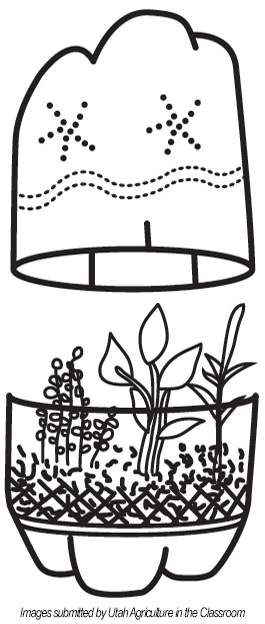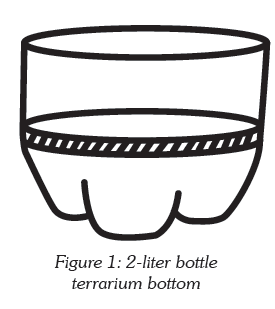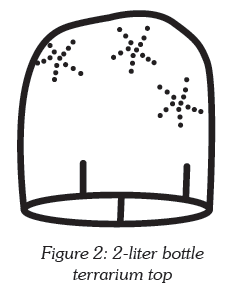It can be easy to forget how interconnected Earth’s systems are. Humans couldn’t exist on Earth without plants, which provide us with food to eat, oxygen to breath, and materials to make our homes, clothes, and more. Plants in turn depend on energy from the sun both for their own sustenance and to help power the water cycle that brings rain. Plants also need nutrients from the soil. Some nutrients come from the nonliving mineral component of the soil and some come from decomposing organic matter, which is the waste created by living and dying plants and animals. In this lesson, students will become more aware of how living and nonliving things work together by creating and observing a terrarium environment.
You may want to begin by allowing your students to go out to the school yard and make two lists—one of nonliving things they see and the other of living things they see. Living things have a number of different identifying characteristics—they are made of cells, obtain and use energy, grow and develop, reproduce, and respond and adapt to their environment. Grass, trees, and other plants are some of the most obvious living things students might see. However, if they look closely at the ground they might notice insects, or if they look to the sky, they might see birds. Ask students to note everything they see as living and nonliving. Guide them to ask the following questions to figure out if something is living: Does it breathe? Does it eat? Does it respond? Does it reproduce? Does it grow?
A rock may be an obvious nonliving thing, but clouds, bike racks, brick, etc., should also be noted. Your school may have some wood playground equipment—is this wood living or nonliving? The truthful answer would be either nonliving or once living. If the roots and leaves were still attached it would be living. You may need to help students make this distinction. Soil has living creatures in it (the soil may seem alive), but the small particles of sand, silt, and clay are rock particles that are nonliving.
The contents of the terrarium should somewhat mimic Earth’s living and nonliving things. Rocks will be added to the terrarium as an important drainage component; the rocks are not living. (Students might like to bring in one special small rock to place in their terrarium on the soil to observe what it does as the plants grow.) Plants on Earth and in the terrarium are living things. They are not only important as human food and shelter or wildlife habitat but also provide oxygen and play an important role in the water cycle. Plants take up water from the soil through their roots, move the water through stems to their leaves, and then as plants “breathe,” the water evaporates into the air through transpiration.
When students plant seeds in their terrariums, they are somewhat mimicking what farmers do when they plant their fields. Just as the seeds in the terrarium depend on living and nonliving things in their environment, so do the farmers’ crops that provide us with food to eat, clothes to wear, and much more. The success of a farmer’s crop depends on the weather, the health of the soil, and the actions that the farmer takes to prevent weeds from growing, prevent pests from damaging the crop, and provide water and nutrients to the growing plants. We all depend on farmers to provide us with food, and farmers must work with the living and nonliving components of Earth’s systems in order to harvest a bountiful crop.

 For efficiency and safety; cut the 2-liter bottles prior to the activity. Decide if you will have each student create their own terrarium (they will prefer this) or make the terrarium as a group.
For efficiency and safety; cut the 2-liter bottles prior to the activity. Decide if you will have each student create their own terrarium (they will prefer this) or make the terrarium as a group. Place the terrariums in a sunny location if possible.
Place the terrariums in a sunny location if possible.